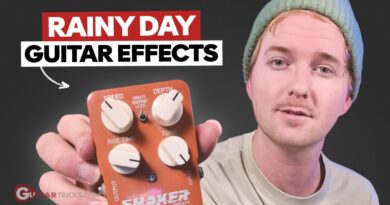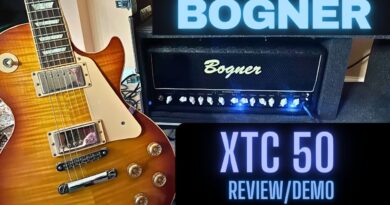Dial in an Amp for Great Country Guitar Tone
Want to know how to get good “Country” tone? Hopefully this video will answer all your tone related questions when it comes to country guitar. We dive into amp settings as well as what pedals I use to achieve my sounds. Unless otherwise specified all sounds heard were the 50/50 mix of the two mics I had set up (no post recording processing other than matching volumes). Thanks for watching, Please Like and Subscribe!
-Steve
link to the hollowtop guitar:
https://colemusic.co
Country Guitar Playlist on Spotify: Listen to the Greats!
follow me on Instagram for more short form guitar content!
https://www.instagram.com/stevetharms/?hl=en
00:00 Get Country Tone!
1:00 Guitar/Amp Intro
1:48 Slapback Delay
4:26 Let’s Talk Compression
9:38 Overdrive/Distortion?
10:16 Fender Princeton
14:04 VOX AC15
19:11 Final Thoughts
#Dial #Amp #Great #Country #Guitar #Tone
Originally posted by UCKeBZCEZf13F_s7nirXEvug at https://www.youtube.com/watch?v=VDb-kC8ebaE




Thanks for explaining how compression pedals work. You explai it well.
I’m an old guy (56 yo) from Europe. And of course there are country music loving people in Europe too, but country music is more of niche market compared to other styles of music in Europe (with a slight exception maybe to the UK). This means that, even as a guitar player (which I am), learning to play the electric guitar is almost completely focused on rock, blues, pop and for the more advanced and/or sophisticated guitarists you will be studying jazz and if you can find a good teacher he will teach you to listen to more modern styles of progressive rock. Country however, at least in my experience (again, I’m old and times do change…) is (again) a niche thing.
Of course guitar players are aware of the fact that some of the very best guitarists are to be found in the country music scene. A scene that is extremely small and almost nonexistent in Europe.
The first guy (which should tell everything you need to know about the popularity of country music in Europe) that I was introduced to, playing a style that combined rock with ‘country music’ and frankly, maybe more bluegrass than country, was Steve Morse. I was already in my twenties when I read about some of the best country guitarists at the time. And I was completely blown away by the techniques of these guys.
Anyway…., I was asked to join a cover band in 2015 and because we didn’t want to be competing with tens of thousands of other bands playing the same songs over and over again everywhere you went, we decided to only play covers from country music artists. This was not as simple as it may seem to those of you who grew up in the USA. Because it was almost impossible to come up with more than 5 songs within that genre (that included everything from classics, to southern rock and everything in between) that everybody could sing along to, without using some of the most obvious choices that nobody really took very seriously, like Glen Campbell’s Rhinestone Cowboy. Don’t get me wrong please, Glen Campbell is a man I respect and learned to love with all my heart and ‘his’ song ‘Wichita Lineman’ is one of the best written songs ever, albeit not really suitable for what we were after (a fun band playing fun songs with a strong country vibe).
Look, just to clear things up a little. Everything I wrote until now is not a black and white story. OF COURSE there’s a community of people in every European country that LOVES country music. These are very fanatical groups of people who literally travel all across Europe to attend country music festivals. And there are differences between these groups as well. One of those fanatical groups of enthusiasts are the line dancing community, who know all the songs that are important in that world of line dancers. I had a friend who played the drums in one of those bands that played throughout all of Europe to do this stuff and he invited me to come and watch him play somewhere in the Netherlands. I was nearby, because I had to play in the same area that day in another band, playing a weird party polka punk crossover style of ‘music’. And I was astounded with what I witnessed. I saw hundreds of people, all dressed up in expensive old western style cowboy costumes (and one ‘Indian’ ????). They must have spent fortunes for the boots and hats alone and they all took it VERY SERIOUSLY!!! I don’t think I saw anyone laughing. ????????
I also met people from another subculture within this country related musical landscape in Europe. And this was another interesting group of people. It seemed like they all knew each other, including the (usually American) artists. And this was a subculture that was less obsessed with dress codes, although I did see more checkered flannel shirts and caps than usual. And the music was definitely more raw. It had elements of bluegrass, folk, but also punk. But still clearly within the boundaries of country music.
Anyway, in search for songs to play with this new country inspired cover band that we just formed, I did what I always do. I went for a musical quest on YouTube and I dove into the world of country music and its history. I listened to countless bands and artists, led by documentaries about country music from the beginnings, via all sorts of crossover styles and subgenres and I spent months in the ever expanding country bubble. I must admit that I started this journey with a lot of reluctance, but as with most genres of music, at some point it’s easy to spot the greats, the originals, the ones that created a stir and you slowly begin to love them. And some of them I think were so great for various reasons, that I became a fan.
THIS PART WILL RELATE TO THE SUBJECT OF YOUR VIDEO (sorry, I can’t help myself. I start to write and I can’t stop. It’s a serious condition that literally keeps me from sleeping ????????):
As a guitarist, playing in a band that decided to create our own versions of all sorts of country music, I expected to be particularly focused on the great guitar players. This didn’t turn out to be the case, much to my surprise. However, I was really keen to find out what I needed to get that typical country sound, because by that time I had already fallen in love with the country twang. However, like I said, I’m not the youngest anymore. I used to play loud. REALLY loud. But that was when I played rock, having roadies to carry all of my stuff. Things changed dramatically. I was 46 when I had to have my right leg amputated below the knee. I couldn’t carry my old AC30’s. I sold a lot of the old stuff. Not my AC30’s though. They were stolen from me. I was broke. My bandmate and another generous friend (I’ll always be grateful for what they did) bought me a new AC15 and some other gear, but I couldn’t really get that country sound. When things were starting to go uphill again, financially speaking, I bought a Morgan AC20, which allowed me to create the sound I wanted, without needing to sacrifice my tone (the singers in the band didn’t allow me to play loud anymore ????). The AC20 gives you the ability to search for that edge of break up sound and then turn down the volume without changing the sound. I already had a good Telecaster, but I replaced the bridge pickup for a Little ‘59 and combined with the extremely bright sounding neck pickup, it was just a magical guitar that I would never want to change. So I bought a beautiful 50’s style Telecaster, I put in a Seymour Duncan Broadcaster pickup, hoping to bring me closer to that country style Tele twang. I also bought a the best MXR Phase 90 I could find (I have a weak spot for Waylon Jennings’ use of a phaser pedal). And despite the fact that I have always hated compressors (I tried and bought so many of ‘em, only to find myself not using them – among the ones I had were pedals like the Keeley Compressor+, the Xotic SP compressor and the Greer Amps Fish Press). Then, given my history of (not) using compressors, I gambled and bought what I believed to be the best compressor in pedal form ever made to this day, namely the Origin Effects Kali76 Double Stacked version. And holy f***, I absolutely LOVE that pedal!!!
However, like I said, I’m not the youngest anymore. I used to play loud. REALLY loud. But that was when I played rock, having roadies to carry all of my stuff. Things changed dramatically. I was 46 when I had to have my right leg amputated below the knee. I couldn’t carry my old AC30’s. I sold a lot of the old stuff. Not my AC30’s though. They were stolen from me. I was broke. My bandmate and another generous friend (I’ll always be grateful for what they did) bought me a new AC15 and some other gear, but I couldn’t really get that country sound. When things were starting to go uphill again, financially speaking, I bought a Morgan AC20, which allowed me to create the sound I wanted, without needing to sacrifice my tone (the singers in the band didn’t allow me to play loud anymore ????). The AC20 gives you the ability to search for that edge of break up sound and then turn down the volume without changing the sound. I already had a good Telecaster, but I replaced the bridge pickup for a Little ‘59 and combined with the extremely bright sounding neck pickup, it was just a magical guitar that I would never want to change. So I bought a beautiful 50’s style Telecaster, I put in a Seymour Duncan Broadcaster pickup, hoping to bring me closer to that country style Tele twang. I also bought a the best MXR Phase 90 I could find (I have a weak spot for Waylon Jennings’ use of a phaser pedal). And despite the fact that I have always hated compressors (I tried and bought so many of ‘em, only to find myself not using them – among the ones I had were pedals like the Keeley Compressor+, the Xotic SP compressor and the Greer Amps Fish Press). Then, given my history of (not) using compressors, I gambled and bought what I believed to be the best compressor in pedal form ever made to this day, namely the Origin Effects Kali76 Double Stacked version. And holy f***, I absolutely LOVE that pedal!!!  In fact, I love it so much that I just don’t see the need to switch it off.
In fact, I love it so much that I just don’t see the need to switch it off.
I have always been a Vox player. I used to play old beaten up, but amazing sounding AC30’s with Celestion T1088 speakers.
And to make things complete, I also bought the Keeley 30ms Double Tracker that I also use for that slapback delay.
AND STILL….. even though I practiced hard to play something that is reminiscent of those fast bluegrass type of licks, I still don’t sound like a country guitar player. ????
And the reason is so obvious. A large part of that sound is the chicken pickin’ technique, using a plectrum AND the middle- and ring finger to pluck the strings. If you played guitar for almost all of your life and you start to practice a couple of those runs for the first time when you’re 51 years old…., unless you’re a fit person, both physically and mentally, with an unbelievable amount of willpower to learn and put in the hours, as in… MANY, MANY hours…., then forget it. I have an enormous respect for people who can do this. People who don’t give up, not even after three months of working on the necessary techniques, only to notice that they’re not even close to comfortably playing the very basics of this style of playing.
I’ve heard wonderful guitarists who had that country twang using what you would only describe as a typical metal guitar, through a Marshall stack. And then there are people like me, who spend thousands of euros (or dollars) to buy all the stuff you always thought you needed to get that typical country twang. But hey, it doesn’t just twang by itself. I couldn’t get this stuff to twang if it would save my life!!! ????
But…. If I would succeed in sleeping instead of typing comments like this all night, then there’s still hope. Damn, I want that twang. How hard can it be? ????
I really enjoy your style of teaching. Lots of great players, not many can teach well. You have a gift of doing both. Please continue to share with us.
I believe John Jorgensen with the Desert Rose Band was the first one doing the Vox thing in Country.
Great demo – Thanks.
Very well done.
Please Sir, do not insult the Fender company with that guitar that is not a Telecaster…
Thank you
Excellent tutorial! i would like to hear what you think about getting a similar sound with other type guitars like a Strat or a Gibson and if you think it is feasible? I sold all my Telecaster type guitars years ago, but like the country sound! You got my subscription!
thanks for the video. done well and straight to the point. In addition … Love your shirt! (got like 3/4 of the way thru and went "heeeeeyy!! Gaslight anthem shirt!!")
Country tone is whatever you have and a tele. There’s no rules.
Killer video dude! Gotta ask, where can I get that hat??
At last, someone that can really play and get the right sound unlike most of the 12 bar Blues crap we get on YouTube, really informative video.
Nice video with lots of useful information. One thing I would say is that compression doesn't compress lower and higher volume. It's lower and higher frequencies that get compressed which intensifies the impact those compressed frequencies have on the sound. It's what give that popping type sound to the notes when you pick them.
i don't play or listen to country at all and i learned so much. sounds soooo good
Im a drummer but I play a lot of rock guitar but man I wish I coild Honky Tonk like that. Such a different style I reckon you just gotta have it in your blood.
Awesome video
Really great video thanks ????????
Great video Steve. Thank you!
I bought a few books on country playing and riffs. Learning major scale playing as well. Board was volume, compressor, delay and might have had a boost not sure if it was a six band eq or a soft clip od. Amp fender vibralux…playing had biggest impact.
The most American video ever. Every guitar player outside America is now scratching their head. ????
Cool
The country tone sounded great with just the amp and guitar… and the player of course! The other pedals added the icing to the cake.
I've heard many similar explanations of how compressors work, and didn't understand it until I realised it wasn't how compressors work! The first part of the explanation is all that was needed. It makes loud sounds quieter. What it doesn't do is make quiet sounds louder. As the difference between the loudest and quietest sound is smaller, it gives the impression that quiet sounds are louder as they are closer in comparison to the loudest sound. Below the threshold setting, the volume does not change at all. The overall sound can be made louder with the gain/volume control but there isn't anything interactive happening to make quiet sounds louder.
Perhaps I'm over complicating things, but it made much more sense to me!
To compensate for bright pickups, we're told to cut the treble on the amp instead of using the treble cut on the guitar. I recently saw a video saying you should do the opposite, boosting treble on the amp and cutting it on the guitar. I wonder why someone would choose one method over the other? Good video.
Good explanation bro. Thank you! For people like myself that may be intermediate players while at the same time starting to learn about effects from scratch, you make the learning process much less daunting. Thanks again.
Yep, if you are going to "kick shit", you need a Telecaster…
Good stuff Steve…got a Q when you were going over boost/distortion usage, when you do use it. Do you typically chain boost/distortion first, then compress…then off to modulation (dly-verb-chorus-vib etc.) <>to amp? Thanks appreciate what you do! …next got to start getting my ring finger and middle finger involved in picking, seems like the entire technique deal breaker.
Very informative video, good job!
It’s all in your fingers. That’s how. Pedals are for little boys. Ask Roy Buchanan, or Tory Slusher. Get a fender twin, and ANY guitar. You would sound exactly the same on ANY guitar.
VOX IS NOT A COUNTRY AMP
Amps should be raised off the floor. Any engineers knows this
I have a twin reverb tone master which channel should I plug into
So refreshing – you explained it so well, really as if the listener had just a basic knowledge of pedals, no fluff. That is a rare thing on YT and many would stretch it out to 1 hour.